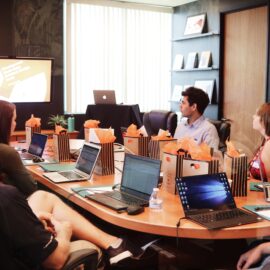
How do you know the world you see around you is real? It’s not, according to neuroscientist and entrepreneur Beau Lotto. In Deviate, Lotto explains that our brains don’t simply record the world as it is, but actively construct reality based on past experiences and evolutionary adaptations.
Below, we’ll explain how our perceptual abilities don’t give us access to objective reality, as well as the evolutionary reasons why this is true. Then, we’ll outline how you can use this understanding of your brain’s abilities to change the way you think and foster innovation. Read more in our overview.
Overview of Deviate by Beau Lotto
In Deviate, Lotto challenges our fundamental assumptions about perception and reality. Through visual experiments and neuroscientific research, Lotto demonstrates that what we perceive as “reality” is actually a personal, subjective construction—a survival tool, not an objective representation of the world around us. His work reveals how our perceptions, experiences, and assumptions shape everything from our daily decisions to our most profound beliefs, and how we can use this knowledge to change the way we think.
Lotto is a neuroscientist, entrepreneur, keynote speaker, and author whose work focuses on perception, creativity, innovation, and leadership. He has a bachelor’s degree in anatomy and physiology and a doctorate in cellular and molecular developmental neuroscience. He’s a visiting scholar at New York University, and he’s also the founder of the Lab of Misfits, the world’s first neuro-design studio, which combines science and art to create immersive experiences that reveal the mechanisms behind perception.
We Can’t See Reality
The way you take in reality is through perception: This refers to the process of receiving sensory input, as well as processing and interpreting it. Lotto explains that we use our senses to form our understanding of everything—our world, our actions, and each other. However, our interpretations of the sensory input we receive don’t reflect objective reality: In other words, what we perceive about the world around us is the product of our brain’s interpretation (in other words, subjective reality), not a true reflection of the world as it is.
Lotto uses the online phenomenon of “The Dress” to illustrate this argument. In 2014, an image of a dress went viral online as people disagreed on what color the dress appeared to be: Some saw it as blue and black, while others saw it as gold and white. Some people also found that their perception of the dress’s color changed from one viewing to another. If our perceptions of the world were accurate, then everyone should see the same stimulus identically. However, in this case, even though everyone saw the same light waves, different people perceived it differently.
Information Has No Meaning
According to Lotto, the Dress situation demonstrates that the information we receive through our senses is, by itself, meaningless. We use our eyes to detect light waves, our ears to detect vibrations, our noses to detect certain chemicals, and so on, but these physical stimuli mean nothing until our brains interpret them and ascribe meaning to them. All animals have similar limitations in their perception.
However, says Lotto, humans are unique in that we can perceive and study our own perceptual abilities, which means we can find ways to change and enhance those abilities—as we’ll see throughout the rest of this guide.
Lotto outlines four reasons why the information we take in has no inherent meaning: 1) Our senses provide only a limited means for perceiving the world around us, 2) the information we receive is constantly changing, 3) the information our senses provide is ambiguous, and 4) there are no prescribed rules for what to do with sensory information. Let’s explore each of these reasons.
Reason #1: Our Senses Are Limited
Lotto explains that our senses can only detect certain types of stimuli, and only in certain amounts. For example, we can perceive sound vibrations, but only in a particular range—animals like dogs can perceive much higher frequencies, while other species can perceive lower frequencies than we can. Those stimuli still exist and are an undeniable part of reality, but our senses don’t give us access to them.
Reason #2: Information Is Constantly Changing
According to Lotto, the information around us is changing constantly. Even though we might perceive something in one instant (for example, a bird on a tree branch), as soon as our brains process that information, it will have changed (the bird will have moved or flown away). So even if we could momentarily perceive objective reality, it would soon transform, and then what we’d perceived would no longer be reality.
Reason #3: Information Is Ambiguous
Lotto explains that every stimulus we perceive through our senses can be interpreted in many different ways. For instance, if you see a dog wagging its tail, you might infer that it’s happy. However, that tail wag could also indicate nervousness, submission, or even aggression. Additionally, all the information we take in comes from a combination of many different sources, which further complicates its potential meaning.
For example, when you perceive the sound of a drum being struck, there are many different sources involved: the drum itself, the acoustics of the room you’re in, the air around you (which is the medium the sound travels through), and the physical anatomy of your ear. If the sound changes—say it becomes quieter—you won’t immediately know what the source of that change is. It could be that the drummer isn’t striking the drum as hard, but it could also be because someone opened a door (so the sound doesn’t resonate as much), because some object has disrupted the air between you and the drum, or even because the volume of the drum has damaged your ear and reduced your ability to hear.
This illustrates how ambiguity obscures the meaning of stimuli: Until you investigate further, you won’t know the reason for (and therefore the meaning of) the change in the stimulus.
Reason #4: There Are No Rules for What to Do With Information
Finally, Lotto explains that the point of our ability to perceive is to respond (to act on the stimulus in some way), but there’s no instinctual rulebook for how we should respond to stimuli. For example, a stick can be used for many different purposes: To fight back against a threat, to build a shelter, to start a fire, and so on. None of these is the innate purpose of the stick. Its purpose and meaning are created by your analysis of its potential uses and your decision on how to use it. Your brain then learns from that decision, which informs how you might use the next stick you find (we’ll explore this idea more in the next section).
Lotto suggests that this explains many of the miscommunications that occur in human interaction. We take in information from others (like body language, verbal communication, and facial expressions) and draw conclusions about them, often misinterpreting them and causing misunderstandings.
Next, we’ll look at the evolutionary reasons for these limitations in our perception.
Why We Can’t See Reality—And Why This Might Be Good for Us
Lotto explains that we can’t see objective reality because of the way our brains evolved. Namely, they evolved to keep us alive, which didn’t require perceiving everything—it only required us to perceive whatever would help us survive. Evolution drove us to avoid uncertainty and to develop assumptions to reduce how much energy our brains had to spend on thinking and predicting. But while these adaptations may prevent us from seeing everything that exists, they can also aid us in using imagination to purposefully see things that don’t exist. Let’s explore both the drawbacks and the benefits of these evolutionary adaptations.
Ways Our Brains Evolved to Keep Us Alive
According to Lotto, our inability to see objective reality isn’t a deficiency, but rather a useful adaptation that’s helped our species survive over millennia: It was more beneficial to our survival to see what was useful than what was “real.” For example, our senses are limited because if we could perceive everything, our brains would be overwhelmed with the input and unable to function effectively. Instead, we evolved to filter out information that wasn’t helpful to our survival, such as certain ranges of sounds, colors, and odors.
This means that what we’re able to perceive was shaped by the environments, or contexts, we evolved in. Because of this, context still heavily influences our perception: Since information by itself has no meaning, as explained earlier, we use context to give it meaning. For instance, if an ancient human heard an indistinct wailing sound that they couldn’t immediately identify, they would use context to fill in the blanks: If someone in their tribe had recently had a baby, they might conclude it was the baby crying. If they were in a remote area replete with wildlife, they might conclude it was an injured animal. If they were approaching a battlefield with an opposing tribe, they might conclude it was an enemy war cry.
Lotto explains that context includes not only our physical environments but also our past experiences. If that ancient human had never heard a war cry, it probably wouldn’t occur to them that that’s what the sound could be. Everything we perceive or learn that proves useful to us becomes a part of our brain’s record, which we then use to inform our present and future. This occurs on both an individual scale through our personal experiences and perceptions, and on a larger scale through the processes of evolution and culture—meaning, what we personally find useful stays with us, and what our ancestors found useful was passed down to us.
Why Not Seeing Reality Can Be Beneficial
Lotto describes our inability to see objective reality as a strength rather than a deficiency. This is because, while it may prevent us from seeing things that exist, our disconnect from objective reality lets us see things that don’t exist. In other words, this perceptual malleability provides us with a unique ability that other animals don’t have: The power to imagine. Lotto explains that we can mentally simulate false realities, allowing us to explore ideas that we could otherwise never conceive of. This power also lets us hold more than one idea of reality in our minds simultaneously.
How to Think Differently
Lotto explains that understanding how your brain works—and that it doesn’t accurately reflect reality—is a powerful tool in coming up with new ideas and new ways of thinking. By identifying the constraints in your thinking, you can access new perspectives and modes of thought that give way to greater creativity and innovation. We’ll explain some ways you can do this next.
Three Steps to Thinking Differently
First, Lotto provides a three-step process for changing how you think: 1) Acknowledge that you’re unaware, 2) identify your assumptions, and 3) complexify your assumptions.
Step 1: Acknowledge That You’re Unaware
According to Lotto, the first step in changing how you think is to understand and acknowledge that you aren’t truly aware of reality. Instead, your understanding of the world consists of assumptions your brain constructed from sensory input based on context and your past experiences. By acknowledging this fact, you open yourself up to testing and overcoming the limits of your perceptions. This will lead you to a stronger understanding of the world and greater access to the true potential of your brain, helping you make better decisions, come up with better ideas, and perceive things you’ve never perceived before.
Step 2: Identify Assumptions
Because we base so much of our thinking on assumptions we aren’t even aware of, we often reject ideas automatically without considering them—simply because they contradict our invisible biases. To change how you think, Lotto recommends identifying and challenging the assumptions you hold. He suggests examining your emotional responses to identify what your assumptions really are.
Step 3: Challenge Your Assumptions
Since your perceptions are based on your assumptions, Lotto explains, the next step to learning to think differently is to challenge the assumptions underlying your perceptions by expanding your space of possibility. This means exposing yourself to new experiences, especially those that make you uncomfortable.
One way to do this is to expose yourself to other cultures. This will not only challenge your assumptions but also add diversity and variety to your experiences, which will expand the range of what you’re capable of perceiving. You can expose yourself to other cultures by traveling or living abroad, but not everyone has the resources to do this. However, since the brain responds to simulated experiences just as it does to real ones, you can use the power of your imagination by reading travel writing and books about life in other countries.
Techniques
In addition to his three-step process, Lotto provides some specific techniques you can use to expand your perception and change the way you think.
Reinterpret the Past
Lotto explains that since your past experiences form your assumptions, the past determines what you can perceive in the future. However, this doesn’t mean it’s unchangeable—in fact, you can change your future by reexamining your past. Specifically, he suggests reviewing your past experiences and assigning new meanings to them so that you have to reconsider your assumptions. The way to do this is to ask “why”: Why did you perceive something in one way and not another? Why do you do things one way and not a different way? Why is the status quo one thing and not another thing?
Lotto explains that all of your assumptions exist in an interconnected web, so when one shifts, they all shift. This expands your space of possibility and is what leads to creative breakthroughs and novel ideas. These can be on a large scale, like great inventions or social revolutions, or on an individual scale, like personal relationships. By questioning your assumptions, you open yourself up to this new perception, which gives you a better understanding of your conflict—and hopefully, helps you resolve it.
Embrace Uncertainty
As explained earlier, humans have an inherent aversion to uncertainty as it can represent a threat to our survival. However, Lotto argues that we need to seek out and embrace uncertainty to perceive more and think differently. Research shows that species that evolve in environments with a lot of uncertainty show more complex processing and greater diversity, both of which improve animals’ ability to perceive stimuli and solve problems.
Lotto recommends that you put yourself in uncertain situations and environments. When you find yourself facing something you don’t understand, refrain from rejecting it at face value and be willing to admit that you don’t understand, despite the discomfort this produces. When you face conflict, view it as an opportunity instead of a threat. Approach it from a place of truly trying to understand it instead of just seeking out ways to defend your current point of view. You’ll find that conflict becomes productive instead of destructive, which will improve your relationships with others.
Furthermore, when you find yourself having a negative emotional reaction to some stimulus, do the following: Stop, then divert your attention from that stimulus to something else. Your instinct is to focus on whatever seems to present an obvious threat, but you only view it as a threat because of your current assumptions. Focusing your attention on something else entirely provides a different stimulus, which activates different assumptions and expands your perception. The more you do this, the less you’ll feel the knee-jerk reaction to uncertainty that prevents you from breaking out of established ways of thinking.
How to Foster Innovation
Lotto also explains how thinking and perceiving differently can foster greater innovation in businesses and organizations. This involves combining play with intention, prioritizing creativity over efficiency, promoting diversity, and leading well.
Play Plus Intention
Lotto explains that innovation requires a combination of play and intention. “Play” means approaching everything with a playful mindset. This involves embracing uncertainty and remaining open to many different possibilities, as well as collaborating with others and having intrinsic motivation (in that you should play for the sake of playing).
However, only when combined with intention does play become innovation. Intention involves a conscious directing of play toward a specific goal, with a focus on exploration and answering an essential “why” question. This combination is perhaps best encapsulated by the entire field of science, which explores uncertainty with an openness to possibilities, often in collaborative settings, both for the sake of science and with the intention of answering “why.”
Creativity and Efficiency
Creativity and efficiency are both necessary for innovation. According to Lotto, we can see the balance between creativity and efficiency in the way our brains develop. Our brains constantly create new connections between neurons and prune away old ones that we no longer need. If either of these processes stopped, our brains wouldn’t function well—without creation, we’d never grow, and without pruning, our brains would be inefficient. However, with these processes combined, the brain develops and grows, allowing it to think, create, and innovate.
Just as the brain needs both of these processes to innovate, so do businesses. However, they often neglect the creative process, to their own detriment. Lotto notes that many businesses have a single-minded focus on efficiency. While this fosters competition and eliminates waste, it also stifles innovation. If employees are judged solely on their efficiency, the work culture will be characterized by a fear of being fired, which prevents the creation of new ideas and puts inordinate stress on workers. Instead, Lotto says that organizations should encourage the creation of new ideas before trimming for efficiency.
Diversity
Lotto also emphasizes the role of diversity (in thought and groups) in innovation. Diversity helps to complexify an environment, which increases the collective space of possibility and allows for more creative and innovative ideas. In particular, he advocates an environment that combines both experts and novices: Experts have the knowledge needed to work efficiently in their environment, but this same knowledge can lead to tunnel vision that inhibits their creativity. Novices, on the other hand, lack the knowledge needed for efficiency but are unconstrained in their thinking about new possibilities.
Leadership
Finally, Lotto explains how good leadership enhances innovation. While uncertainty is vital for creativity and innovation, it’s still frightening. This fear can manifest through negative emotions, such as anger, but it can also be transformed into productive feelings, like bravery. A leader’s role is to guide their team through uncertainty. Research shows that the best leaders model what they want to see in others, are willing to acknowledge when they’re wrong, and notice other people’s positive traits. Lotto suggests that great leaders understand the principles of perception explained throughout this guide, and that they embody principles like combining play with intention, balancing creativity and efficiency, and promoting diversity.






